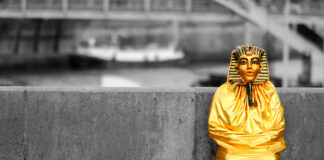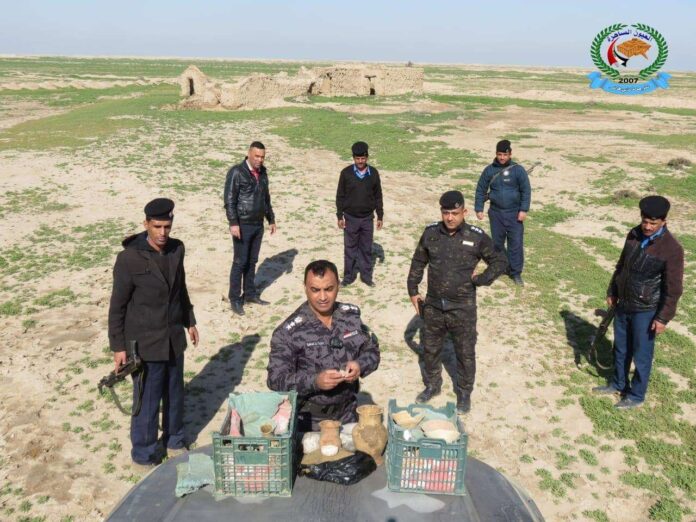
The British Museum and Border Force have worked together on a case which highlights a side of the trade in antiquities which is rarely discussed: objects which are faked to appear as the genuine article. On 1 July 2019 two metal trunks were opened at Heathrow airport after catching the attention of an eagle-eyed Border Force officer. They were consigned from Bahrain to a private address in the UK. The trunks were found to be completely filled with as many as 190 clay tablets covered in cuneiform script, fired clay figurines, cylinder seals and rather unusual and imaginative animal-shaped pots. All were individually packaged in bubble-wrap and parcel tape. Photographs of a selection were immediately taken and sent to the British Museum, rapidly followed by the objects themselves for closer expert identification.
At the Museum, experts in the Department of the Middle East examined the photographs and objects. Suspicions arose almost immediately as the ‘cuneiform’ tablets seemed to represent a virtually complete range of basic types known from ancient Mesopotamia: cushion-shaped school texts designed to be comfortably held in one hand and written on one side only, prisms and cylinders designed for burial as building inscriptions, administrative texts, but also votive mace-heads, inscribed dedicatory wall cones, a royal inscription referring to the late Assyrian king Adadnirari, a mathematical tablet and an inscribed amulet resembling a unique example excavated at the Assyrian capital of Nimrud.
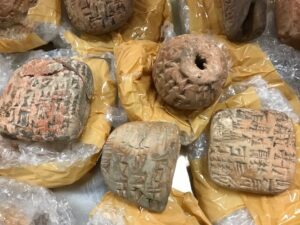
It was as if the whole genre of ancient Mesopotamian writing was represented in one shipment: an entire collection ready for a single uninformed buyer. But it was immediately clear that there was a problem; not one of the objects was ancient. Some of the inscriptions on the tablets contained real signs and the royal inscription began with a known formula and imitated one carved from stone; the amulet was undoubtedly inspired by that found at Nimrud. The rest of the inscriptions were a jumble of signs, some invented, others upside-down, a complete mish-mash which made no sense when read. The clay was all of a similar type, which would be impossible for such a wide chronological and functional range of genuine inscriptions from different sites. If real these tablets would have been dried in the sun but in this case they had all been fired deliberately and consistently and to a relatively high temperature, thus proving that they were the product of a modern workshop with a kiln. Indeed, the clay itself is of the wrong type for the types of tablet. The sizes and thicknesses of the tablets do not match those of the originals, a common error of the forger working from photographs in a book.
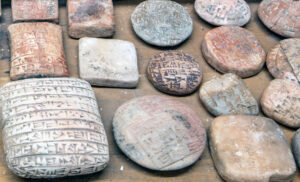
It is undoubtedly easier and cheaper to make copies than it is to hire dozens of workers to look for originals. Moreover, fakes can be conveniently complete, whereas almost everything from antiquity has been broken, either deliberately in episodes of destruction, or accidentally in the case of everyday items. There is also the simple economic truth of the laws of supply and demand. It is highly risky to loot archaeological sites in countries such as Iraq and Iran, where the death penalty has been awarded for such offences as they are considered such serious breaches of national antiquity laws. The large-scale looting of sites in southern Iraq which took place in the immediate chaotic aftermath of the overthrow of government, law and order after the American-led invasion in 2003 ended long ago. In Iraq today there is a highly efficient and armed archaeological police service who regularly patrol sites and guard museums and archaeological projects 24/7.
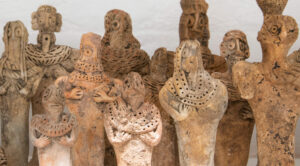
In this case therefore someone has chosen to find another solution to fuelling the market, and that is through making copies and passing them off as originals. The whereabouts of the workshop is uncertain but is likely to be within the Middle East. Clay fakes like these have no monetary value at all but, if offered as a genuine collection to an unsuspecting buyer, would undoubtedly have been passed off as extremely valuable and given a price tag of thousands of pounds. Faking tablets has been known for over 200 years, fakes began to appear even before cuneiform had been deciphered. But this is the first time that fakes of this particular type have been seen: this is a new production line aimed at a fresh gullible market. However, thanks to the efforts of Border Force and subject matter experts the traders didn’t get far, the fakes were stopped from reaching their intended destination and seized. The fakes will instead now be used for teaching and training purposes and a selection will go on display for a short period at the British Museum when it reopens.
Hartwig Fischer, Director, the British Museum: ‘The British Museum works closely with UK law enforcement to help advise them about objects which they believe to have been stolen or illegally trafficked. Our curators are experts and one of their important roles is to identify objects, both genuine and faked, quickly and professionally. This is yet another example of positive collaboration, of organisations working together to crack down on harmful illegal trade’.
St John Simpson, Curator, the British Museum said: ‘These seizures confirm an emerging trend: capitalising on interest in the purchase of antiquities, unscrupulous traders are faking Middle Eastern objects for sale. These consignments confirm the importance of vigilance on the part of our law enforcement agencies and the role that museums need to play in the identification of these objects. It seems very likely that more trunks of fakes are out there, that there are more fakes than there are genuine objects. Consignments which are almost too perfect to believe should be treated with great caution’.
Richard Nixon, Border Force Heathrow senior officer, said: ‘Organised crime gangs are usually the drivers behind the counterfeit trade and by making this seizure, our experienced officers have taken a substantial amount of money out of the hands of criminals. The links we have forged with experts at the British Museum were a vital part of this case and we will continue to work closely with them, as well as law enforcement partners, to stop counterfeit goods.’
Indeed, the cultural heritage crimes are a minuscule portion of worldwide crime as the World Customs Organisation’s Illicit Trade Report 2018 showed.
Against all political claims there has never been real evidence of trade in ancient art funding ISIS.
And you may want to read this interesting article on how the international art market has been made a kind of cultural bogeyman.



